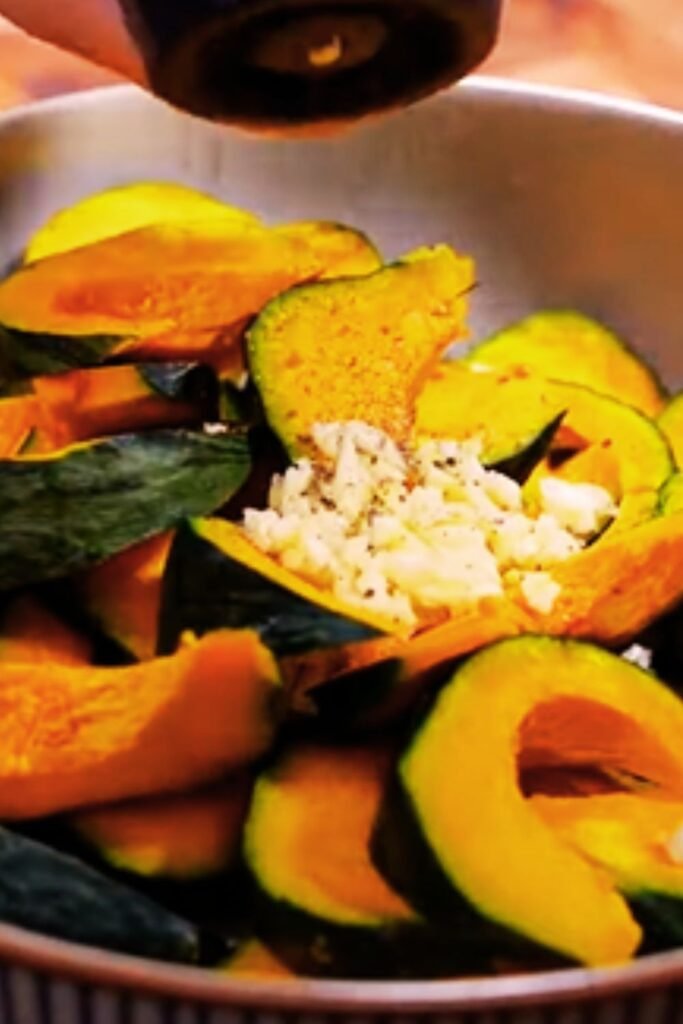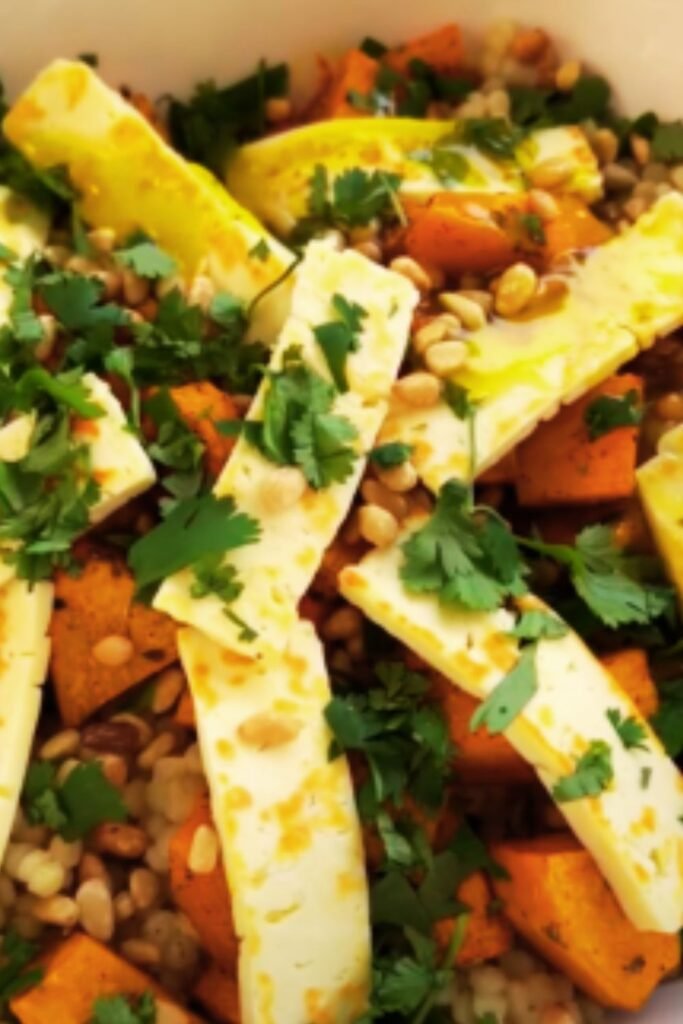There’s something magical about the arrival of pumpkin season that brings a smile to my face. The markets suddenly burst with these glorious orange orbs, and I immediately start dreaming of all the delicious possibilities. While pumpkin pie and soup certainly have their place, today I want to share one of my absolute favorite ways to enjoy this versatile vegetable: Roasted Pumpkin with Lemon Yogurt Sauce and Pine Nuts.
This dish beautifully balances sweet, tangy, and nutty flavors while highlighting the natural sweetness of perfectly roasted pumpkin. I’ve been perfecting this recipe for years, and it’s become my go-to fall side dish when entertaining guests or simply treating myself to something special. The combination of creamy yogurt sauce with the warm, caramelized pumpkin creates a truly memorable experience that celebrates the best of autumn produce.
Why This Recipe Works
Before diving into the recipe details, let me share why this particular combination is worth your time:
- The high-heat roasting method caramelizes the pumpkin’s sugars, intensifying its natural sweetness
- The tangy lemon yogurt sauce cuts through the richness of the roasted pumpkin
- Toasted pine nuts add essential textural contrast and a buttery flavor dimension
- Fresh herbs brighten the entire dish and add visual appeal
- The entire recipe uses simple ingredients but delivers complex, layered flavors
When I first created this dish, I was looking for something that would make pumpkin the star without hiding behind heavy spices or too much sugar. The result is elegant enough for special occasions but simple enough for weeknight dinners.
Choosing the Perfect Pumpkin

Not all pumpkins are created equal when it comes to cooking. While those giant jack-o’-lantern pumpkins look impressive, they’re bred for size and durability rather than flavor. For this recipe, I strongly recommend using:
Sugar pumpkins (also called pie pumpkins) : These smaller pumpkins (typically 2-4 pounds) have sweeter, less stringy flesh perfect for roasting.
Kabocha squash : If you can’t find sugar pumpkins, kabocha makes an excellent substitute with its sweet, nutty flavor.
Butternut squash : While technically not a pumpkin, butternut works beautifully in this recipe with its smooth texture and sweet flavor.
Red kuri squash : Another excellent alternative with a chestnut-like flavor that works wonderfully with the yogurt sauce.
When selecting your pumpkin, look for one that feels heavy for its size, has intact stem, and has no soft spots or mold. The skin should be dull rather than glossy, which indicates it’s fully mature.
Ingredients
For the Roasted Pumpkin:
- 1 medium sugar pumpkin (about 3-4 pounds)
- 3 tablespoons extra virgin olive oil
- 1 tablespoon maple syrup (optional, but adds wonderful depth)
- 1 teaspoon ground cumin
- ½ teaspoon ground coriander
- ¼ teaspoon cinnamon
- ¼ teaspoon smoked paprika (optional)
- 1½ teaspoons kosher salt
- Freshly ground black pepper
- 2 sprigs fresh rosemary
- 3-4 sprigs fresh thyme
For the Lemon Yogurt Sauce:
- 1 cup full-fat Greek yogurt
- 1 small garlic clove, finely grated or minced
- 2 tablespoons fresh lemon juice
- 1 tablespoon extra virgin olive oil
- 1 teaspoon honey
- 1 tablespoon fresh mint, finely chopped
- 1 tablespoon fresh parsley, finely chopped
- ½ teaspoon lemon zest
- ½ teaspoon kosher salt
- Freshly ground black pepper
For Garnish:
- ⅓ cup pine nuts, toasted
- ¼ cup fresh pomegranate seeds (when in season)
- 2 tablespoons fresh mint leaves, torn
- 2 tablespoons fresh parsley leaves
- Flaky sea salt (such as Maldon)
- Extra virgin olive oil, for drizzling
Essential Equipment
I find having the right tools makes preparing this dish much more enjoyable:
- Sharp chef’s knife
- Sturdy cutting board
- Large rimmed baking sheet
- Parchment paper
- Small mixing bowl for the sauce
- Heavy skillet (for toasting pine nuts)
- Microplane grater (for garlic and lemon zest)
- Sturdy spoon for removing pumpkin seeds
Preparation Steps
Preparing the Pumpkin:
- Preheat your oven to 425°F (220°C) and line a large baking sheet with parchment paper.
- Using a sharp chef’s knife, carefully cut the pumpkin in half from stem to bottom. I find it easiest to first insert the tip of the knife near the stem and work my way down.
- Scoop out the seeds and stringy flesh with a spoon, saving the seeds for roasting later if desired.
- Cut each pumpkin half into 1-inch thick wedges or crescent shapes.
- For easier eating, you can peel the pumpkin before roasting (I recommend a Y-peeler for this task), but I often leave the skin on as it becomes tender when roasted and adds beautiful color to the dish. The skin is perfectly edible on sugar pumpkins!
Roasting the Pumpkin:
- In a large bowl, combine olive oil, maple syrup (if using), cumin, coriander, cinnamon, smoked paprika, salt, and several grinds of fresh black pepper.
- Add the pumpkin pieces and toss gently to coat evenly with the oil and spice mixture.
- Arrange the pumpkin pieces in a single layer on the prepared baking sheet, ensuring they don’t overlap. Nestle the rosemary and thyme sprigs between the pieces.
- Roast for 25-35 minutes, flipping the pieces halfway through, until the pumpkin is fork-tender and nicely caramelized at the edges. The exact time will depend on the thickness of your wedges.
- While the pumpkin roasts, prepare the yogurt sauce and toast the pine nuts.
Making the Lemon Yogurt Sauce:
- In a medium bowl, combine the Greek yogurt, grated garlic, lemon juice, olive oil, honey, chopped mint, chopped parsley, lemon zest, salt, and a few grinds of black pepper.
- Whisk until smooth and well combined.
- Taste and adjust seasoning as needed, adding more lemon juice for acidity or honey for sweetness.
- Refrigerate the sauce until ready to serve, allowing the flavors to meld.
Toasting the Pine Nuts:
- Heat a dry skillet over medium-low heat.
- Add the pine nuts and toast, stirring frequently, until golden brown and fragrant, about 3-5 minutes. Watch them carefully as they can burn quickly!
- Immediately transfer to a plate to cool.
Assembling the Dish

- Arrange the roasted pumpkin wedges on a serving platter, removing the herb sprigs.
- Drizzle generously with the lemon yogurt sauce, reserving some to serve on the side.
- Scatter the toasted pine nuts over the pumpkin and yogurt.
- Sprinkle with pomegranate seeds (if using), torn mint leaves, and parsley.
- Finish with a light sprinkle of flaky sea salt, a few grinds of black pepper, and a drizzle of your best olive oil.
- Serve immediately while the pumpkin is still warm and the contrast between warm pumpkin and cool yogurt sauce can be enjoyed.
Nutritional Information
This dish isn’t just delicious—it’s nutritionally impressive too! Here’s a breakdown of what you’re getting in each serving:
| Nutrient | Amount per serving | % Daily Value |
|---|---|---|
| Calories | 285 | – |
| Protein | 7g | 14% |
| Carbohydrates | 23g | 8% |
| Dietary Fiber | 4g | 14% |
| Sugars | 9g | – |
| Fat | 21g | 27% |
| Saturated Fat | 4g | 20% |
| Vitamin A | 12,550 IU | 251% |
| Vitamin C | 12mg | 13% |
| Calcium | 145mg | 15% |
| Iron | 2mg | 11% |
| Potassium | 564mg | 12% |
*Values based on 4 servings. Percentages based on a 2,000 calorie diet.
Serving Suggestions
This versatile dish works beautifully in numerous settings:
- As a stunning side dish alongside roasted chicken or grilled lamb
- Tossed with farro or another hearty grain for a satisfying vegetarian main course
- As part of a mezze or appetizer spread
- Atop a bed of arugula for a substantial salad
For a complete fall harvest meal, I love pairing this with:
- Herb-roasted chicken thighs
- Wild rice pilaf with dried cranberries
- Sautéed garlicky greens like kale or Swiss chard
- A simple green salad with apple cider vinaigrette
Make-Ahead and Storage Tips

One of the things I love about this recipe is how well it works for meal prep and entertaining:
- The pumpkin can be cut up to 2 days ahead and stored in the refrigerator.
- The yogurt sauce can be made up to 3 days ahead and kept refrigerated.
- Pine nuts can be toasted up to 1 week ahead and stored in an airtight container.
- Fully assembled leftovers will keep for 2-3 days in the refrigerator, though the pine nuts may soften slightly.
For entertaining, I often roast the pumpkin earlier in the day, then reheat it briefly in a 350°F oven just before serving. This frees up valuable oven space and reduces last-minute preparation.
Recipe Variations
While I love this recipe as written, here are some delicious variations I’ve tried over the years:
Spice Variations:
- Za’atar seasoning instead of cumin and coriander for a Middle Eastern twist
- Curry powder and garam masala for Indian-inspired flavors
- Harissa paste mixed with the olive oil for a spicy North African variation
Nut Alternatives:
- Toasted walnuts or pecans instead of pine nuts
- Pistachios for a beautiful green color contrast
- Pumpkin seeds (pepitas) for a thematic touch
Yogurt Sauce Adaptations:
- Add 2 tablespoons tahini for a richer, more complex sauce
- Stir in 1/4 teaspoon saffron threads soaked in hot water
- Replace the herbs with 2 tablespoons finely chopped preserved lemon
Vegan Adaptation:
- Replace the yogurt sauce with a cashew cream base
- Use maple syrup instead of honey in the sauce
- Add nutritional yeast to the cashew cream for extra flavor
Troubleshooting Tips
Even experienced cooks can encounter challenges. Here are solutions to common issues:
- Pumpkin not caramelizing? Make sure your oven is truly hot before adding the pumpkin, and don’t overcrowd the baking sheet.
- Pumpkin too hard to cut? Microwave the whole pumpkin for 2-3 minutes to soften slightly, making it easier to slice.
- Yogurt sauce too thin? Use the thickest Greek yogurt you can find (look for brands that contain only milk and cultures), or strain regular yogurt through cheesecloth for several hours.
- Burnt pine nuts? Toast them at a lower heat and keep them moving in the pan. Alternatively, toast them in a 325°F oven for 5-7 minutes, stirring once.
- Sauce too tangy? Balance with a bit more honey or reduce the amount of lemon juice.
Frequently Asked Questions
Q: Can I use canned pumpkin instead of fresh?
A: For this recipe, fresh pumpkin is essential to achieve the caramelized edges and proper texture. Canned pumpkin has a completely different consistency and wouldn’t work for this roasted preparation.
Q: How do I know when my pumpkin is perfectly roasted?
A: The pumpkin should be easily pierced with a fork but not mushy. Look for nicely browned edges and a slightly wrinkled appearance on the cut surfaces.
Q: Is there a dairy-free alternative to the yogurt sauce?
A: Absolutely! Try using a thick coconut yogurt as your base. The slight coconut flavor actually pairs beautifully with the pumpkin and spices.
Q: Can I roast the pumpkin seeds instead of using pine nuts?
A: Yes! Clean the seeds, toss with a little olive oil and salt, and roast at 325°F for 10-15 minutes until golden. They make a wonderful crunchy topping.
Q: What’s the best way to reheat leftovers?
A: Reheat the pumpkin in a 350°F oven for about 10 minutes. I recommend adding fresh yogurt sauce after reheating rather than reheating the sauce, which can separate.
Q: Can I freeze roasted pumpkin?
A: The roasted pumpkin freezes beautifully for up to 3 months. Freeze it separate from the sauce and garnishes, then thaw in the refrigerator overnight before reheating.
About Pumpkin’s Health Benefits
While this dish is undeniably delicious, it’s also packed with nutritional benefits. Pumpkin is an exceptional source of:
- Beta-carotene, which converts to vitamin A in the body, supporting eye health and immune function
- Fiber, promoting digestive health and helping you feel satisfied longer
- Potassium, which helps balance electrolytes and support heart health
- Vitamin C, supporting immune function and skin health
- Antioxidants, which may reduce inflammation and protect against certain chronic diseases
The yogurt adds calcium and protein, while pine nuts contribute heart-healthy monounsaturated fats and magnesium. This combination makes the dish not just a treat for your taste buds but nourishment for your body as well.
A Personal Note
I first discovered my love for this pumpkin preparation during a fall visit to a small farm-to-table restaurant in Vermont. The chef had paired similar flavors with locally grown pumpkins, and I was immediately smitten with the combination. Over the years, I’ve adjusted and refined the recipe to what I’m sharing with you today.
What I love most about this dish is how it elevates the humble pumpkin from a seasonal decoration to the centerpiece of a sophisticated meal. Every time I serve it, guests are surprised by how complex and satisfying properly prepared pumpkin can be.
I hope this recipe brings as much autumnal joy to your table as it has to mine over the years. There’s something deeply satisfying about transforming a seasonal vegetable into something truly special that celebrates the bounty of fall.
Looking for More Pumpkin Inspiration?
If you enjoy this recipe, you might also love these pumpkin-based dishes from my collection:
- Pumpkin and Black Bean Enchiladas with Mole Sauce
- Creamy Pumpkin Risotto with Sage and Mascarpone
- Thai-Inspired Pumpkin Coconut Soup
- Pumpkin Gnocchi with Brown Butter and Crispy Sage
- Warm Pumpkin and Quinoa Salad with Maple Vinaigrette
Happy cooking, and enjoy your delicious roasted pumpkin creation!

